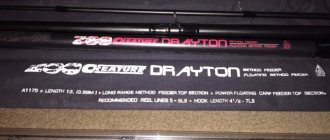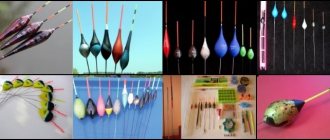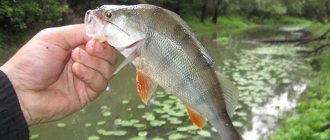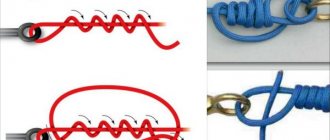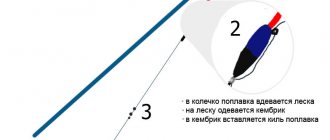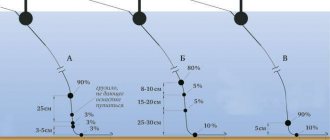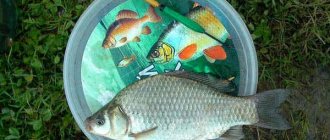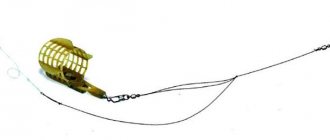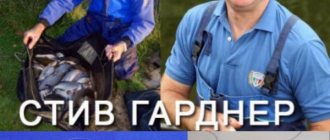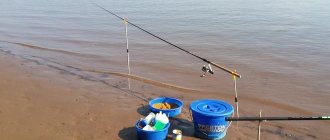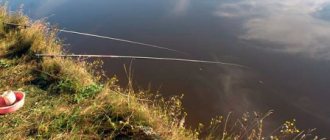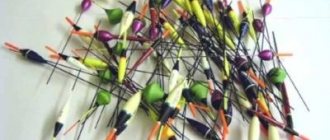Most beginner fishermen who have not grasped the “zen” of this hobby are wondering about the correct gear. It’s easy to choose the ideal fishing rod and line; just ask a specialist and he will present suitable options. But with the choice of float the situation is different. There are over 2000 models sold in stores, which differ from each other. Therefore, choosing the right product can be difficult. In order not to buy useless products, the editors of the YaNashla website have prepared for you a rating of the best floats for 2021.
Design features
Despite the wide range, all elements consist of three main parts - keel, body and antenna. Most of the differences lie in these structures, so it is important for a person to know what they are.
Antenna
This part is designed to notify the user of a bite. Typically, it is painted in bright colors so that it can be easily spotted even at night. There are many varieties, they can be: thin or thick, long or small, empty or full-bodied, transparent or colored, etc. Each characteristic affects the quality and characteristics of fishing.
Thickness
The fishing range depends on this parameter. If you buy a thin version, it is important to understand that the float will be sensitive, which can create problems when catching fish at a long distance. A person simply will not be able to detect the signal. Therefore, for such fishing it is recommended to buy products with a thick antenna. But if there is no wind, then models with thin walls are suitable, the main thing is that there is a foam ball at the end.
Hollow
If fishing takes place in places with high currents, then this is one of the best options. The main feature of this design is good buoyancy. If small debris is encountered, the float will ignore it, maintaining stability, which will prevent false hooking. When the user fishes in the dark, it is advisable to install a luminous “firefly” element so that the product can be easily detected.
Full-bodied
This option is most common; buoyancy is close to neutral. However, it is important to understand that such products will not cope with large currents and will go under water. This option shows the bite many times better.
Replaceable floats and with glued antenna
Replaceable floats are a universal option; they will allow you to fish in any area and time of year. So, if a person fishes during the day, orange antennas are suitable, for dark times a light green color is a good option, and when fishing is planned at night, the best solution is a glow-in-the-dark antenna. However, for the latter option, it is preferable to buy glued options, as they will provide the user with greater reliability, and the part will not be lost in the water space. For better visibility, a cambric is installed.
Transparent products
During daylight hours, such floats are very popular, as they make it possible to see the top at a considerable distance. The thing is that sunlight is reflected from the antenna, which creates a certain glow effect, the range of which extends over a considerable distance. A person gets the impression that there is a small light bulb inside.
If the user does not want to spend money on this option, then such an antenna can be easily created using improvised means. All you need for this is a gel pen. The construction procedure is as follows:
- The required length of the rod is cut;
- Painting a toothpick in a bright color (painting work is carried out with varnish);
- Fixing the painted element inside the workpiece;
- Removing excess and gluing with second glue.
For standing reservoirs, you can use products without an antenna. However, the fishing distance, in this case, is reduced. The advantage of this option is good stability in strong gusts of wind, which makes it possible to fish more carefully.
Body
If it’s not so difficult to decide on an antenna, then you need to pay special attention to choosing a body. Each configuration is individual and designed for specific fishing conditions and styles. So one is suitable for currents, while others show excellent results only in still water.
A universal solution for areas with a current are products with the shape of a drop, olive, spherical, and also shaped like a cigar. The elongated shape, or otherwise called a “goose feather”, is a suitable solution for still waters, as such floats are highly sensitive.
In addition to wind, current floats cope well with sea waves and remain in one position. This is important to consider, especially when the user is going to hunt bream, carp or crucian carp. Such fish will not bite if there are various vibrations of the bait.
For long-distance casting, products in the form of an inverted drop or olive are suitable, since this shape contributes to less wind resistance. Ball-shaped structures are perfect for high-quality fishing when catching “sensitive” fish.
Knowing these nuances will allow you to choose reliable and popular models.
Keel
This part is designed to align the equipment, as well as to fix the product in one position. When fishing in the current, it is better to use a long structure, as it provides better support, which is why the equipment will not move in different directions. It is important to understand that such structures must be installed correctly. For this, cambrics are used, they are placed on the fishing line, their number depends on the length of the keel.
In small bodies of water where there is no current, models with a short keel are used. This option will be less noticeable to the fish, which will have a positive effect on fishing.
Keels can be iron, carbon and plastic. The first option is preferable to use in strong currents, as it will provide the best stability and allow the use of a small load. The main disadvantage of this solution lies in the material itself; if a person accidentally deforms it, then returning it to its original shape will be a real problem. Therefore, for long distances it is best to use plastic or carbon options.
Types of floats and their purpose
A float is one of the most ancient and widespread devices for catching fish. The main purpose of the float is to timely signal a bite. Therefore, it should be clearly visible on the surface of the reservoir at any time and in any weather. Other purposes for which the float serves are to hold the bait at a certain fishing depth, as well as the ability to deliver the bait to a certain distance.
Floats are made from various lightweight, non-moisture-absorbing materials. Previously, they were made from wood, cork and dry reeds, cattails, and kuga. Also popular were and remain floats made from goose feathers or porcupine thorns. Nowadays, floats are made of plastic and balsa. Currently, there is a huge variety of shapes and colors of floats. You walk into a store and your eyes widen.
This is due to the fact that a universal float suitable for all fishing conditions has not yet been invented. For calm, windless weather and fishing on a still body of water (lake or pond), floats of the same shape are suitable. For fishing in the current and in windy weather - another.
Almost all floats are designed the same
They consist of three parts:
- antennas,
- body (body),
- keel
The antenna is the visible part of the float, thanks to which the angler notices the bite. It comes in different thicknesses, lengths and is painted in bright colors. The antenna is selected in such a way that it is clearly visible at the required distance and provides as little resistance as possible when biting. Nowadays, there are even floats in which the antenna can be replaced, depending on the conditions.
The keel of the float is responsible for its stability. It can be of different lengths and is made of plastic or metal. The main part of the float is the body. It is responsible for its carrying capacity, i.e. what weight of equipment (sinkers, swivels, hooks, nozzles) can be used with the float and it will not sink.
Based on their body shape, floats can be divided into several types:
Spindle
A common form in which the body of the float is not much thicker than its antenna and keel. This type also includes floats made from goose feathers. Such floats are highly sensitive and clearly show even the lightest touch of the fish on the nozzle. Floats of this shape are ideal for fishing on a still body of water in calm weather. However, such conditions are rare.
When fishing, even in a weak wind or in a current, such floats begin to dive and lie on the water. Another disadvantage of this form is their small load capacity (up to 2 - 3 g). With such floats it is difficult to deliver the bait over long distances. In this regard, such floats are used mainly with a fly rod for fishing not far from the shore.
Also interesting: Spindle-shaped float
Olive shape
More versatile shape. Such floats can be used both on ponds and lakes, and on rivers with weak currents. They are not afraid of small ripples or weak winds. When loaded correctly, the bite is very clearly shown. They are used for fishing mainly with a fly rod at relatively shallow depths (up to three meters).
Thomas drop
This is a derived form of "olive". Very stable floats that perform well on bodies of water with slight waves and ripples. These floats have a noticeable thickening of the body on the keel side, which is why their center of gravity is shifted downward. This gives them greater stability. Such floats are used when fishing at depths of one and a half meters with almost any float tackle.
Ball-shaped float
This form is also considered universal, like the “olive”. Used for fishing in still waters, in currents, in calm or windy weather. However, it is inferior to “olive” in sensitivity.
Inverted drop
Floats of this shape are very convenient for fishing in currents, as they have greater resistance to sinking than the floats described above. These floats are also convenient to use when you need to hold the float while floating freely. This fishing tactic is often used when fishing with a Bolognese fishing rod, which is why such floats are simply not replaceable here.
Flat floats
They are made in the form of a flat disk with an antenna and keel attached to it, the latter being attached at an angle to the antenna. Such floats are the most stable when fishing in currents. To attach the float to the fishing line, the design of the float includes winding rings that can be installed on the keel and on the body (closer to the antenna).
Sometimes the ring on the body of the float is replaced by a tube passing through the body. This is due to the fact that when rings are used, the line often damages the body of the float during long casts and during sharp hooking. The winding rings on the body of the float can be made of steel wire or plastic, but it is better to avoid the latter. Plastic rings are often simply cut by the line after a few casts. There are floats without rings at all. The line in them is passed through the entire float.
Based on the method of attachment to the fishing line, floats are divided into two groups: sliding and fixed (deaf).
Also interesting: Mission LUCKY BITE. How to choose a float
Blind floats do not have a winding ring on the keel and are used only with a fixed mounting method. The fixed method is considered the most convenient and best method because it allows you to obtain the greatest sensitivity. It is used for most existing floats. With this method of fastening, the fishing line is threaded through the winding ring on the body of the float, and secured on the keel with at least two cambrics. The lowest (outermost) cambric should protrude slightly beyond the edge of the keel onto the fishing line.
If floats with a lower winding ring (at the end of the keel) are used, then the float is attached to the fishing line using a fastening unit. Such a knot is made of steel wire, which is threaded into the winding ring and twisted.
For twisting, two cambrics are selected to attach the fishing line to the twist. Another method of securing such floats in a fixed manner is using lead pellets or silicone stoppers. In this case, the fishing line passes through the winding ring, and pellets or stoppers located on both sides of the float fix its position on the fishing line.
The sliding method of fastening is used only when the fishing depth is greater than the length of the rod itself. For this method of attachment, floats with a lower winding ring are used when fishing with a match rod or Bolognese rod. To attach floats in this way, you can simply thread the fishing line through the winding ring, but it is better to use a special sliding equipment with a swivel, which is sold in any fishing store.
A special group of sliding floats are floats for match fishing of the “wagler” type. These are floats designed for long-distance casting and have their own outlet at the bottom. This load is usually made in the form of removable washers that can be easily removed, changing the load depending on fishing conditions.
On the cases of such models two parameters are indicated, for example “6+2”. Where “6” is the float’s own load (6 grams), and “2” is the weight of the load (2 grams) that needs to be added to the line to fully load the float. If during fishing the washer is removed from the float, then a weight of the same weight should be added to the fishing line.
In conclusion, I would like to say that everything said above is a general classification, and not a dogma. Each fisherman selects floats to suit his taste, with which it is easy and convenient to fish and enjoy the process.
Rating of the best drop-shaped floats
Expert 201-54-025
An excellent option that is suitable for fishing in still water. Load capacity is 2.5 grams. Length – 180 mm, which is a balanced option. The body is made of balsa and the keel is made of carbon. More suitable for summer time. The type of equipment is sliding.
Sold at a price of 90 rubles.
OnExpert 201-54-025
Advantages:
- Suitable for bream;
- Low cost;
- The keel is made of carbon;
- Optimal length.
Flaws:
- Not detected.
COLMIC BIG 2.0-6.0
If a person is looking for a decent option for the current, then this is the best representative. In addition, the product will cope with carp fishing in ponds. The antenna is clearly visible at night and during the day, which allows you to monitor it well. The keel is made of carbon fiber, this makes it more balanced.
The average price is 120 rubles.
COLMIC BIG 2.0-6.0
Advantages:
- Efficiency;
- Suitable for current;
- Carbon fiber keel;
- For carp in ponds.
Flaws:
- Not detected.
Cralusso Milan 0.5g
A universal model designed for fishing in bodies of water with small or medium currents. The product can be used for fishing with a Bologna or fly rod. High stability during currents is ensured by a long keel, which is useful when holding fishing. And the thin and unremarkable antenna will not scare off even the most cautious fish.
The average price is 115 rubles.
Cralusso Milan 0.5g
Advantages:
- Length - 195 mm;
- Loading weight 0.5 g;
- Suitable for medium flow;
- Versatility.
Flaws:
- Not detected.
Paternoster for the float track
The following equipment (Fig. 5) is considered more suitable for fishing on lakes from a boat, but it has also been successfully tested when fishing from the shore with long-distance casting. The equipment is made as follows. A stop knot is tied on the main line, then a transparent ball (not filled with water) is passed along the line through one eye, then a swivel is tied. We tie a fishing line to its second eye, taking into account the fishing conditions, length and thickness, equal to the main fishing line or a little thinner. A sinker is attached to the end of this line. We tie several leashes on the sides - a regular paternoster.
There are two possible options here.
In the first case , the load is heavy and it sinks the float, which, due to its buoyancy, maintains the equipment in a relatively vertical position. Floaters usually value this type of equipment while rowing, slowly moving around the water area, looking for fish sites. This method is very good for searching for perch, which has a decisive grip and which often hooks itself. On the hooks of leashes you can put not only natural bait, but also artificial things, for example, small, well-playing twisters, Christmas tree rain, strips of inflatable balls and other homemade and branded baits. This method of perch fishing can be successful not only from a boat, but also from the shore: we cast, slowly pull up, the transparent ball acts as an assistant, because it tends to help the equipment take a vertical position, which benefits our paternoster, especially if there are a lot of leashes .
The second version of this equipment implies that the transparent ball remains afloat, which means that we select a light weight, weighing less than the carrying capacity of a ball not filled with water. In this case, the working descent can be varied both by the length of the fishing line to which the leashes are attached, and by the location of the ball on the main fishing line, because the locking unit can be moved up and down.
Top quality spindle floats
Hitfish 15 5g
A universal option that is suitable for various situations. This stability is largely possible due to the good shape of the hull. Balsa is used in the production of floats; it is a proven material that is popular with many fishermen. Product length – 210 mm. The maximum loading weight is 5 grams, the antenna diameter is 6.5 mm.
Sold at a price of 59 rubles.
Hitfish 15 5g
Advantages:
- Efficiency;
- Reliability;
- Clearly visible at a considerable distance;
- Length;
- Universal application.
Flaws:
- Not found.
Colmic Velox 0.068
This product is for flow only. The keel is made of durable steel, which allows it to remain stable even with strong water flow. The antenna is made of plastic. The float is preferable to use for delicate fishing.
The average price is 190 rubles.
Colmic Velox 0.068
Advantages:
- Good materials;
- Better stability;
- Durability.
Flaws:
- Not found.
Hitfish 18 3g
A good product with a bright antenna that will notify the fisherman in time about the bite. The product is made from balsa. The length of the product is 180 mm, while the antenna diameter is 4.8 mm. The maximum loading weight is 3 grams.
Sold at a price of 57 rubles.
Hitfish 18 3g
Advantages:
- Good brightness of the antenna;
- Versatility;
- Quality manufacturer.
Flaws:
- Not detected.
Rating of flat floats
Trabucco Oracle 6.00g
This option is designed for fishing in bodies of water with a current. Due to the special features of the hull, the product has minimal windage, which increases stability. The body is made of balsa. There is a special element that allows you to fix the fishing line more tightly.
Sold at a price of 382 rubles.
Trabucco Oracle 6.00g
Advantages:
- Good wing shape;
- Efficiency;
- Sustainability;
- Convenient line fixation.
Flaws:
- Not detected.
Cralusso Shark 1g
An unusual model that can be made to move with and against the flow. In addition, a person can independently choose in which area the equipment needs to be stopped. The length of the product is 180 mm, while the diameter is 1.5 mm. The permissible loading weight is one gram. Designed for fishing in places with current.
The average price is 495 rubles.
Cralusso Shark 1g
Advantages:
- Durable housing;
- Stability even with strong flow;
- Removable antenna.
Flaws:
- Not found.
FLAGMAN FCS08
A high-quality float designed for fishing in currents. The product holds the equipment well, the body is made of balsa, the antenna is made of plastic, and the keel is metal. Thanks to this solution, the float shows high stability on the water.
The average price is 520 rubles.
FLAGMAN FCS08
Advantages:
- Durable housing;
- Beautiful appearance;
- Efficiency.
Flaws:
- Price.
Classic version with blind equipment
This is the most common “fly fishing” option (Fig. 1), standing at the very origins of the use of a transparent ball. The float rig is simple: the main line is tied to one eye of the ball, the leash with bait is tied to the other eye. The equipment is good, allowing the bait to approach the fish before the float on the river during surface fishing, without scaring it away. But the equipment also has several disadvantages.
Firstly, tying by the ears, especially if the holes in them are not perfectly processed, is not very reliable - thin fishing lines can fray under load, which threatens an offensive breakage. But this problem can be easily solved - you can either carefully polish the holes of the ears, or knit a fishing line through thin, soft plastic cambrics. In good, high-quality balls, brass bushings are pressed into the holes of the ears, which are gentle on the fishing line. However, if the fish is not very careful, then the leashes can be attached to the eye of the ball using metal fasteners (to which it is good to add a swivel), which, in addition to the reliability of the fastening, allow you to quickly change the leashes.
A more significant drawback of such equipment is the danger of overlap when casting, especially if the leash is long. And cautious large fish can force us to use a long leash (often exceeding 1 m), because they are often afraid of a large alarm. It is, of course, practically transparent, but if it does not move in the general rhythm of the flow, then the fish is perfectly recognized as something foreign, and what is not visible is even worse: an incomprehensible, invisible danger is always alarming. But the problem of overlap is only a problem of casting technique. Here we can recommend the traditional “counteraction”: at the final phase of casting before splashing down the equipment, it is worth slowing down the run of the fishing line from the reel spool, while the leash will “overtake” the float and, stretching out in a straight line, will lie on the water without tangling.
It often happens that a fish (primarily a small one) completely ignores the ball, treating it completely indifferently, and sometimes even plays with it, pushing it with its nose, which is especially typical for small, bold chubs. In this case, it is better to put a short leash, with which there will be significantly fewer overlaps, and the number of empty bites should decrease. The biggest disadvantage of a blind rig is that there is no direct connection between the bait and the tip of the rod, and the fish, if it is not hooked by a heavy float, can spit out the bait, alerted by the same weight of the ball.
The best ball floats
Float ball AGP 30 gr.
A good model that is suitable for catching predatory fish. Withstands strong gusts of wind and does not move to the side. Body material: foam. Load capacity – 30 grams. Produced in Russia.
The average price is 100 rubles.
Float ball AGP 30 gr.
Advantages:
- Excellent resistance to strong winds;
- Clearly visible at long distances;
- Efficiency.
Flaws:
- Not found.
Namazu 107 2g
A popular option with a spherical shape, which will allow you to fish even in strong winds. The product is made of quality materials. Even though the antenna is short and has a diameter of 6mm, it is still clearly visible at long distances, which is a big advantage. The total length of the float is 190 mm. Attaching to the fishing line is carried out through a special eyelet.
Sold at a price of 57 rubles.
Namazu 107 2g
Advantages:
- High-quality materials were used in production;
- Durability;
- Good visibility.
Flaws:
- Not detected.
Feather shaped floats
FISHING POINT PSHP(4)TL
A high-quality float, which is sold in a classic form and is distinguished by visibility over long distances. Provides a person with good sensitivity, which will allow them to detect even the smallest and most insignificant bite. The main thing is to load the element correctly, then the person will achieve the maximum effect.
The average price is 146 rubles for 10 pieces.
FISHING POINT PSHP(4)TL
Advantages:
- Good sensitivity;
- Price;
- Ease of use.
Flaws:
- Not detected.
Three Whales Gusinka Mega 30-40cm
A good model made of goose feather. It has good efficiency. Suitable for catching bream. Product length – 25 cm.
The average cost is 60 rubles.
Three Whales Gusinka Mega 30-40cm
Advantages:
- Efficiency;
- Reliability;
- Sensitivity.
Flaws:
- Not found.
Zerban 71-03 5g
A reliable product, which is made in the form of a “goose feather”. Produced in Germany. It is best to use a float in calm waters, only there the fisherman will be able to unleash the potential of this element by 100%. The antenna is painted in a bright color, which makes it possible to detect it at a considerable distance. Total length – 190 mm.
Sold at a price of 135 rubles.
Zerban 71-03 5g
Advantages:
- German quality;
- Sensitivity;
- Two attachment points.
Flaws:
- Price.
Inverted drop floats
Cralusso Starlight 1203 1g
A good product with a removable antenna that has the ability to install a firefly. Suitable for use in medium flow conditions. Made from balsa. It shows excellent bites when rising and sinking, and thanks to the elongated keel it does not move.
The average price is 135 rubles.
Cralusso Starlight 1203 1g
Advantages:
- Shows good bite;
- Efficiency;
- Reliability;
- Good price.
Flaws:
- Not found.
Namazu 101 4g
A durable device that is suitable for bodies of water with small currents. The manufacturer recommends using the model for blind rigs, which are most often used in terry fishing rods. Thanks to its bright color, the antenna is visible from a long distance.
The average price is 53 rubles.
Namazu 101 4g
Advantages:
- Strength;
- Good geometry;
- Suitable for current;
- Length 27 cm.
Flaws:
- Not found.
Rybolov-Olta FB111
A domestically produced float, which was designed taking into account the characteristics of the Russian terrain. Wind and average currents are not a threat to this element; in almost all situations, it will show good durability. Supplied on a reel for easy storage and transportation.
The average price is 90 rubles.
Rybolov-Olta FB111
Advantages:
- Efficiency;
- Good load capacity;
- Sustainability;
- Bright antenna.
Flaws:
- Not detected.
Transparent float with a blade of grass
This equipment can be successfully used when catching the most cautious, distrustful fish that are capricious in clear water. The main idea of the rig is to make the fish's leash completely invisible, eliminating even the slightest suspicion. To do this, some fishermen use a thin reed or some suitable hollow grassy stem that can easily be found on the shore. The equipment is the same as the previous one, only a reed or grass is put on the leash and only then a hook is attached. When retrieving, the picture looks like this: the rig goes upstream along the river, the float goes behind, the leash with the hook in front. A reed (blade of grass) with its edge rests directly on the hook, completely masking the leash. Yes, the fish sees the grass perfectly well, but this is the most ordinary object, which is constantly being chased back and forth by the river current, and it does not alarm the fish in any way. And then there was such a seductively moving bunch of maggots, a grasshopper or a worm clinging to the edge of the reed...
